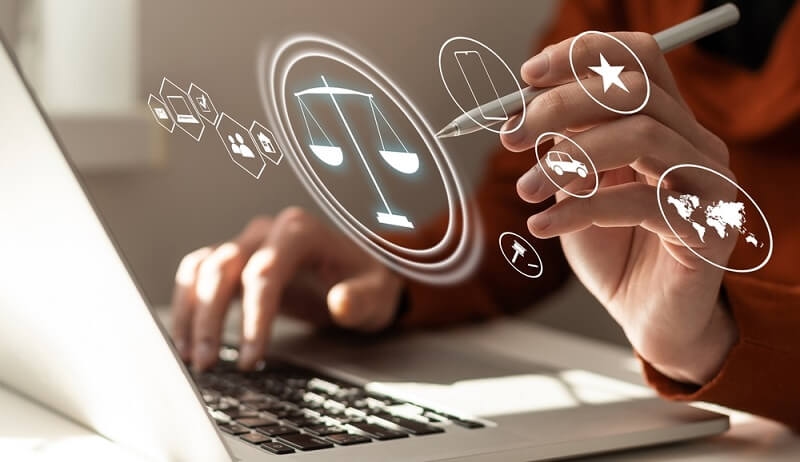Legal Topics

Digital Courtrooms: VR Evidence & Remote Trials in 2025
Once upon a time, courtrooms were all about stiff suits, paper files, and people nervously waiting for their names to be called. Fast forward to 2025, and that image is—well, still there—but now it’s accompanied by virtual reality headsets, remote court hearings, and even AI-assisted evidence review. Welcome to the era of digital courtrooms—where legal proceedings are evolving faster than ever, and no one has to argue over a broken fax machine anymore.
But what exactly is happening in these futuristic courtrooms? Are VR and AR just shiny gimmicks, or are they actually improving how justice is delivered? Let’s take a deep dive into how virtual evidence and remote trials are transforming the legal landscape.
What Does a Digital Courtroom Look Like Today?
Picture this: a judge presides from chambers in Washington, a witness testifies via secure Zoom link from Mumbai, and a jury watches a 3D-rendered crime scene unfold through VR headsets in a quiet room in Orange County. Sounds like sci-fi? It's not.
Digital courtrooms today blend physical and virtual spaces to accommodate modern needs. With hybrid models, not every party needs to be in the same room—or even the same country. Documents are shared through secure cloud platforms. Exhibits can be 3D models. And trial timelines? Often faster, more flexible.
Yes, it’s efficient. But it also comes with a learning curve, a fair bit of tech hiccups, and a need to balance innovation with tradition.
VR and AR in Evidence Presentation: Just a Trend or a Game-Changer?
Let’s be honest—flipping through a stack of printed accident photos doesn’t quite have the impact it used to. Enter VR and AR. When done right, they do more than just impress the courtroom—they clarify facts.
Virtual Reality (VR): Used for full reconstructions. Think car crash simulations, crime scene walkthroughs, or even medical malpractice visuals.
Augmented Reality (AR): Adds layers of data on real-world visuals. A malfunctioning machine can show both its intended operation and the faulty behavior—side-by-side.
When jurors can “see” what happened, comprehension skyrockets. And for expert witnesses trying to explain technical jargon, VR and AR become storytelling tools—minus the confusion.
Remote Court Hearings: Convenience Meets Controversy

Let’s talk about one of the biggest shifts: remote hearing options. When COVID-19 accelerated their adoption, many thought it was a temporary fix. But remote courtrooms have proven too convenient—and in many cases, too efficient—to let go.
The DC Superior Court remote hearings now handle traffic violations, family matters, and even civil disputes without anyone stepping into a courtroom. And in small claim court remote hearing Orange County, plaintiffs resolve disputes from their own homes—often in less time and with lower legal costs.
But it’s not perfect. Tech issues, lack of access to devices, and concerns over a defendant’s “digital presence” have raised important ethical questions. Are all parties truly being heard? Are nonverbal cues being lost?
Still, for many, the convenience is undeniable.
Legal Hurdles and Gatekeepers: Admitting VR and AR Evidence
It’s not all plug-and-play. Introducing AR and VR content into trials means walking a legal tightrope.
Courts still demand:
Full disclosure of how simulations were created.
Verified, timestamped source data.
Qualified experts to authenticate the exhibit.
Judges want demonstratives that aid clarity—not bias the jury. And as you’d expect, opposing counsel gets a chance to review, challenge, or object.
Bottom line: It’s not enough to “wow” the courtroom. It has to meet the rules of evidence, or it’s out.
As Previously Covered: What Is Legal Tech and How It Transforms Business Ops
Remote Depositions and Pre-Trial Uses
VR and AR aren't confined to trial day. Legal teams are now using them during:
Witness prep: Simulated courtrooms reduce anxiety.
Depositions: Remote participants can view AR overlays in real-time.
Mediation: VR accident reconstructions often help parties reach settlements faster.
But it takes planning. Court reporters must sync transcripts. Tech staff must ensure platform compatibility. And yes, everything needs to be saved in backup formats—because Wi-Fi never goes down at the right time.
Witnesses in a Virtual World: Prep Looks Different
Testifying in court has always been intimidating. Now imagine doing it while trying to navigate Zoom, screen shares, or a VR headset.
That’s why law firms are investing in mock virtual trials. Witnesses rehearse with the same tech they’ll use during actual proceedings. They learn when to pause for screen transitions. They understand how long it takes for a judge to load a visual.
And for expert witnesses—engineers, doctors, or financial analysts—these tools let them translate complex knowledge into visuals jurors can actually grasp.
When Remote Trials Work Best
Let’s not pretend every case needs a digital overhaul. But here’s where it shines:
Small claims courts like the ones in Orange County: Speed and efficiency are what matter.
International cases: When it's not possible to go or it's too costly.
Technical disagreements: When visual aids stop "death by PowerPoint."
High-risk situations include things like public health problems and security challenges.
And when courts like the DC Superior Court are openly using hybrid forms, it's clear that this is no longer the future. It's now.
The Cost Factor: Is Tech Worth the Spend?
VR and AR sound expensive—and they can be. Custom animations, expert review, equipment rental… it adds up. But so do drawn-out trials, confused juries, and overturned verdicts due to miscommunication.
Law firms are learning to weigh:
The price of making demonstratives
Against the time saved in trial and the chance to settle quicker
Using technology wisely may frequently make arguments stronger and results go more smoothly. That's when the ROI becomes evident.
And then there's the human factor.
Don't forget that technology can only accomplish so much. You still need to be able to feel for people in a digital courtroom. It still requires clear arguments, well-prepared witnesses, and judges who are impartial. It still needs to be trusted.
So no, VR won’t replace lawyers. Zoom won’t make court clerks obsolete. But used wisely? These tools amplify what the legal system already aims to do—deliver justice clearly, fairly, and accessibly.
Related Resource: Discover Why Builder Reputation Matters When Buying a Flat
Final Verdict: Innovation With Intention
Digital courtrooms are no longer just a side project; they're changing the way trials appear and feel. Remote court sessions make it easier to go to court. VR and AR make things clearer. And together, they help the law keep up with a world that changes quicker every day.
Yes, it's not perfect. But with the appropriate safety measures, the correct planning, and an emphasis on justice instead than theatrics, 2025 may be the year when tech and law finally get it right.
Current Topics
1. AI ChatGPT Tools in Artificial Intelligence for Lawyers
The world of law is evolving at a pac...
2. What Are the Employment Laws Protecting Worker Rights?
In contemporary jobs, it...
3. Financial Resilience Explained for Stability & Success
Money is so cumulative i...
4. What Are Gig Economy Jobs? Legal Rights You Must Know
The way people work has changed drama...
5. Rights & Mediator's Role in Pregnancy Child Support 2025
The first idea that will come to the ...
6. Digital Courtrooms: VR Evidence & Remote Trials in 2025
Once upon a time, courtrooms were all...
7. How to Find a Good Lawyer Made Simple for Beginners
The first question that ...
8. What Is B Corp Certification & Why Law Firms Want It In 2025
In 2025, impact matters....
9. Key Legal Insights on Division of Property in Divorce
Divorce can be a tough t...
10. Post-Dobbs Abortion Laws: What Women & Providers Must Know
In June 2022, the U.S. S...
